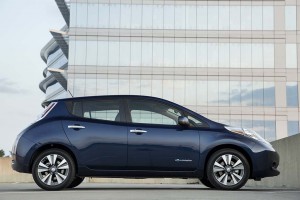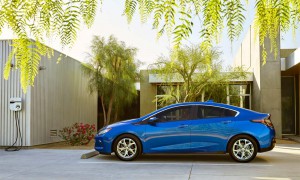In 2011, President Barack Obama predicted there would be 1 million EVs sold in the U.S. by 2015. He would have been correct if only he had expanded the scope a bit … to the world.
More than just a call to action as part of that year’s State of the Union speech, the administration implemented several federal policies aimed at trying to make that happen, including a $7,500 tax credit toward the purchase of an EV.
In total, the government will spend $7.9 billion through 2019 trying to bolster the appeal of and raise the purchase numbers of battery electrics, plug-in hybrids, etc. Critics have been quick to call the effort a failure, and if one only takes a cursory look at the numbers, they would be correct.
However, a deeper examination shows that despite remarkably low gas prices – the biggest disincentive to EV purchases – EV sales are continuing to ramp up in the U.S. and globally. The global number just surpassed 1 million units last month.
As of August 2015 about 985,000 units had been sold worldwide, not including Japanese sales numbers which were not reported yet. That number jumped to an estimated 1,004,000 PEVs though the middle of this month, according to HybridCars.com. The breakdown is about 62% battery electric and 38% plug-in hybrids.
(Volkswagen, Audi announce plans to “electrify” entire line-up. For more, Click Here.)
The U.S. accounts for more than a third of those sales, while China and Japan make up about 15% and 12%, respectively. The surprising country holding down the fourth spot? Norway. The Scandinavian country boasts 66,000 plug-in vehicles sold there. The Netherlands rounds out the top five, according to the site.
The top 10 selling EVs globally, which account for more than 93% of the sales, include:
- Nissan Leaf (200,00)
- Chevy Volt (100,000)
- Tesla Model S (85,000)
- Toyota Prius (74,000)
- Mitsubishi Outland PHV (70,000)
- Mitsubishi i-MIEV (50,000)
- BYD Qin (38,900)
- BMW i3 (31,600)
- Renault Zoe (31,400)
- Ford Fusion Energi (24,100)
(Click Here for details about Ghosn’s commitment to electric, autonomous vehicles at Nissan.)
However, the biggest thing to note is not the total number, but the number sold in the last 14 months, which is about half of the total. Driven by growing sales of the Nissan Leaf and the Chevrolet Volt, which account for 20% and 10% of the 500,000 units sold during that time, sales of EVs got to 1 million faster than hybrids (the non-plug variety).
It helps that there are a growing number of options across the pricing spectrum ranging from the Tesla Model S, which can top $100,000, to the Kia Soul, which can be had for under $20,000. Additionally, the segment is growing.
(To see more about how GM plans to bolster EV sales, Click Here.)
During the recent Frankfurt Motor Show, BMW, Audi and Volkswagen all introduced new EV versions popular models and the latter two committed to producing electric versions of all the models in their line-ups at some point in the future.



The U.S. government has not spent a dime. U.S. tax payers are footing the bill for the stupidity of Obama and the EPA. Elon Musk and others are laughing all the way to the bank. Thankfully some states have woken up and are eliminating these absurd incentives for a product that is impractical for and rejected by most of society.
The fact that the U.S. is the largest consumer of these impractical vehicles proves that the rest of the world knows that clean Diesels are far more practical. Unfortunately Obama and the EPA have conspired against the U.S. populace to prevent the consumption of clean Diesels. This is just another example of bad government exploiting tax payers for the benefit of a few, just like with the gasohol scam.
In my State there is no incentive, and yearly registration is exactly 10 times what it would be if the car were conventionally powered.
And M is correct about the super-strict clean diesel standards. In my other home town in Italy, over 80% of cars are diesel, and this change has happened in most of the world – and it’s not smoggy, stinky, or smoky on the packed streets in Europe. Now VW’s way around those standards will make it even less likely we’ll get more of those strong-running, economical cars (I’ve got two of them).
It looks like the ICE crowd has forgotten to take their medication today. Reduction of nitrogen oxide is accomplished reinjection of exhaust in to the engine at appoximately 2500 degrees f. A chemical process. Gas or diesel. Drivability and mileage will be affected if other factors are constant. Any ICE fan know what year the first catalitic convertor was first installed american diesel? How about gas?
Call it tech trivia. Well?
1975 & 2010 mandated on the convertors. I am not an ICE fan but that is how I make a living. I drive EVs and have had an affair with the diesels since 1979. EVs are the future. The numbers do not lie.
Cost per mile on an EV cannot be touched by a ICE. Do the math and be honest. I drive a Leaf for .22 per mile total. I can give you any ICE and you can not come close.
DWH is in deep, deep denial and personally attacks anyone who doesn’t buy into the EV foolishness. When faced with the reality that EVs are impractical for about 99% of the world, DVH starts with his flat earth mentality because he can’t deal with being wrong.
As far as ICE is concerned, they will be the dominant power source long after all of us are dead and gone. Electricity doesn’t grow on trees and it isn’t free. Much electricity in the U.S. is currently produced by coal – which environmentalist hate, despite the efforts to make it a clean energy source. Cost per mile varies dramatically with maintenance cost. $30,000 Tesla S batteries every 6-8 years drive EV cost up considerably.
LoL GT101 personal attacks?
I see the ICE supporters drama queens are at it again. I belive VW just put a nail in the coffin of the diesel in america, probably europe also. And electricity does fall from the sky for free they call it solar also known as sunshine! For free! LOL Girls remember there is no maintence for all electric cars. You ICE Drama queens must rememeber the cost of battery has already dropped from 1000 kw to 400$ per kw to in about 100 per kw with the gig factory next year. Lets see about 8000$ EXTENDED RANGE PACK. Thanks for the attention, Girls!
Fantastic! Don I also drive a Nissan leaf. Good answers. And yes I also make a living the same way. Be careful we are in the flat earth chanters that hate EVs. Just the words ELon Musk sends them into a frenzy of muttering of obama and government spending. You are correct about the evs. Espicially if you have solar on your roof. Fueling your transportation from a individuals home fantastic! Glad to have you on board for evs.. But be careful of the pied piper of the misinformed. Mostly political mumbo jumbo.,with oil corporation worship. A puzzling combination. Have a good day.